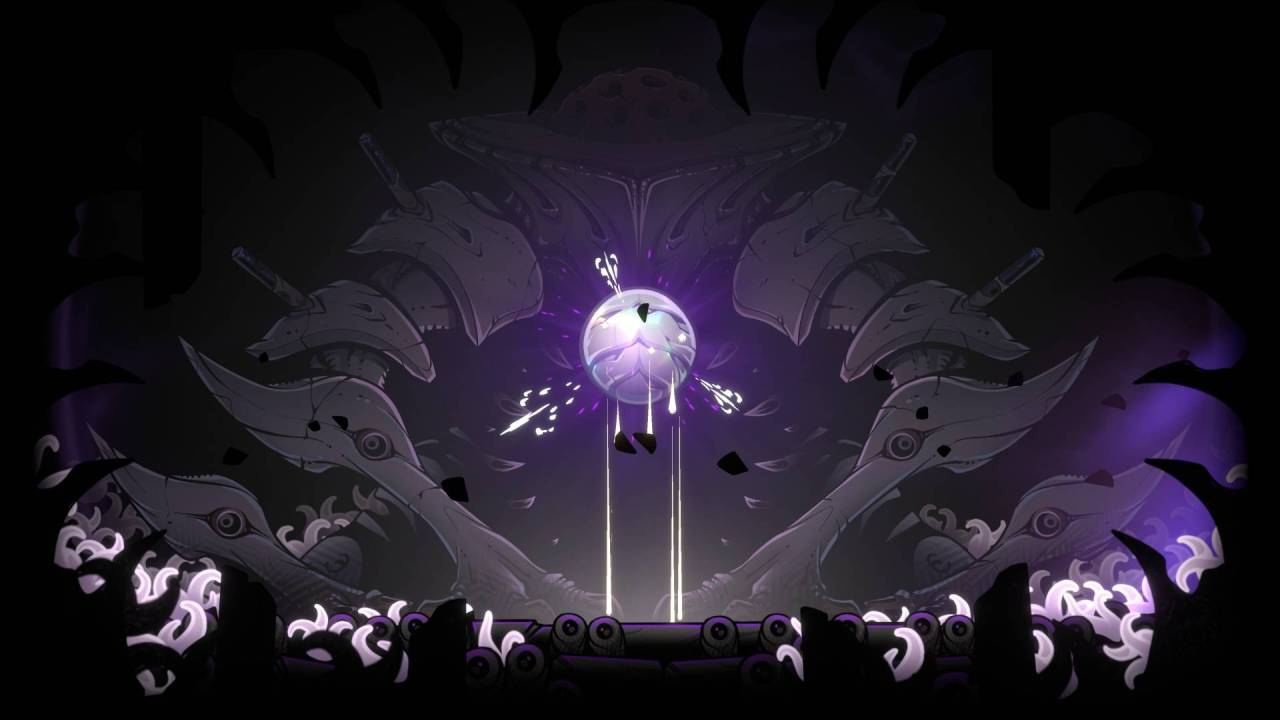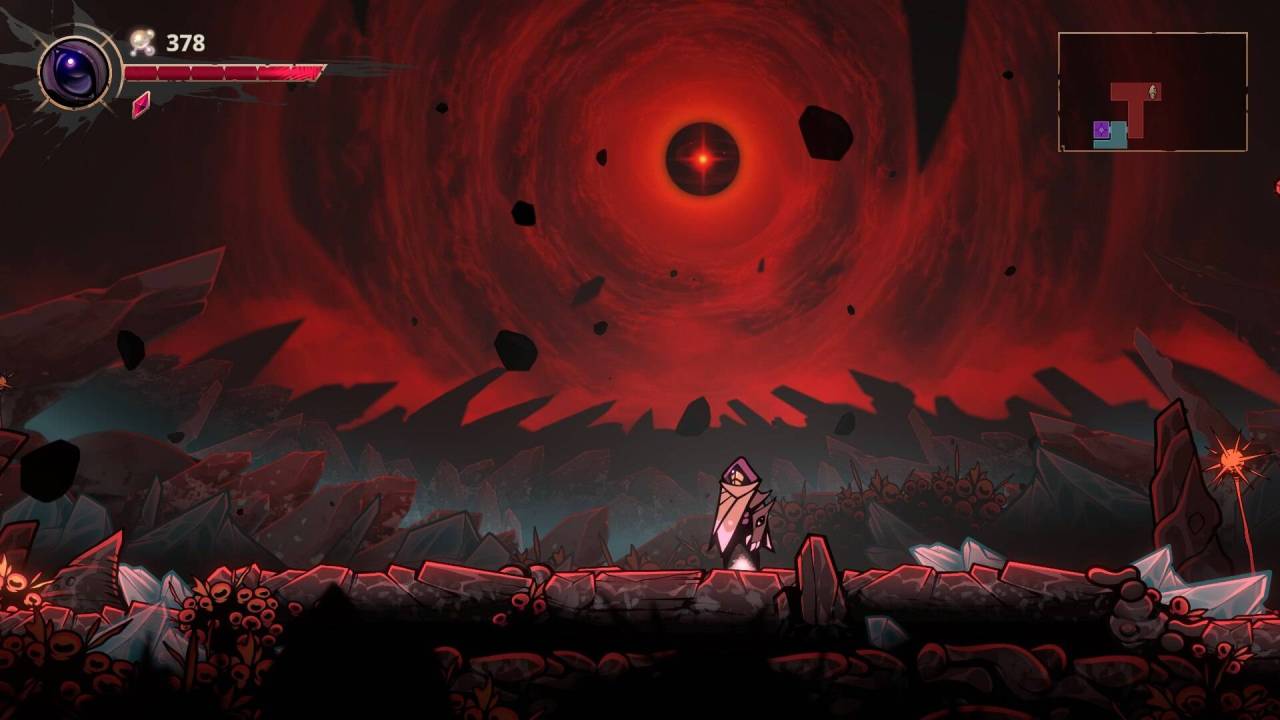Imagine Hollow Knight meets ancient Egypt—yeah, Voidwrought’s pretty cool.
With how often metroidvanias come along, you would think the genre feels oversaturated, but when you have titles like Nine Sols, Bo: Path of The Teal Lotus, Tales of Kenzera: ZAU, and Prince of Persia: The Lost Crown come along, it is difficult not to feel refreshed.
Voidwrought can be considered part of the refreshing pack despite being one of the numerous titles inspired by Hollow Knight. Given Silksong’s asymptotic development time, developer Powersnake took matters into their own hands and decided to make their own video game, and it has really got some presence.
The atmosphere may be the first thing you notice when you start Voidwrought. You are thrown into an environment that is simply thematically appropriate. It’s all hand-drawn and beautifully executed, so you can’t help but admire it.
Narratively, we have a mix of traditional Souls-style storytelling here. What I mean is that we have obscure storytelling, a few ambiguous pieces of text and information, and a slew of unusual characters—exactly what we wanted.

What’s nice about this is that we also have elements of a past civilization, such as machines and mechanical components scattered throughout the environments, and a lot of visual storytelling to that end.
Voidwrought also employs Egyptian symbolism with a futuristic twist and small holographic projections of historical figures, such as archaeologists, to provide a glimpse back in time at this civilization.
For those of you who care about the story, it’s very light. You will come across characters with whom you can interact, and Voidwrought will occasionally provide you with something to do, but I frequently found myself simply searching for my next form of progression, as there was no strong narrative focus.
However, there is a significant amount of lore, and what there is is interesting. The compendium contains Heralds, regions, and beings that are all worth reading. I believe there should have been more emphasis on notifying you when a new entry was added.
Voidwrought proudly wears its inspiration on its sleeves. You can control your character and launch fast-paced attacks in all directions. If you take damage, you’ll need to heal up with one of the shards. To accomplish this, press and hold a button.

Voidwrought has gone for a few subtle nuances in combat here. One of these is that when you attack, your character moves slightly backward. That becomes an intrinsic mechanic of the combat, giving it a slight advantage over its competitors. We’ve seen similar systems in which the character pushes forward slightly, but the rear motion takes some getting used to and is extremely useful for avoiding damage.
Aside from these, you also have a dodgeball. Interestingly, this does not initially provide you with invulnerability, but it can do so later on with a small bonus. You can also jump around and perform downward attacks to keep yourself suspended in the air, and there’s a lot of traversal that requires you to jump precisely around the environment.
Now, if I had to describe the controls in Voidwrought with one word, it would be precise. They feel very tight, have low input latency, and provide good aerial control when necessary, but they are not at all floaty. However, there are a few improvements I would make here.
One is that when you hold up or down on the controller to look in that direction, I’d like it to happen instantly. There are times when you want to quickly glance down over an edge to ensure you’re not about to fall to your death, and the half-second latency is unusual. Perhaps some animation would add to the sense of control.
Before you can explore the other areas, and even before you gain the ability to grab ledges, you must defeat your first Herald. Heralds are the main bosses in Voidwrought.

Each one is distinct, as is the arena space that they occupy, and each appears to be well-balanced in terms of what abilities you should have at the time or the bare minimum of abilities with which to leave the Commons area. Heralds typically guard a room with a new upgrade.
The Heralds aren’t easy, but the difficulty of later ones varies depending on the abilities you unlock, as well as the equipable Souls and Relics you can gain or purchase.
You can begin to collect them after defeating the first Herald and gaining the ledge grab ability. There are three slots available to equip Souls at once. These are passive bonuses that can provide a variety of benefits, such as increased health, shorter healing time, or the addition of a projectile to your attack based on your health level.
Up to two relics can be equipped and used for the cost of Void Charges, which are located next to your health bar. Most relics can deal damage in addition to your primary attack. To fill the meter and activate your relics, land successful attacks or visit a save point.
You can get more Void Charges after reaching a certain level of progress and by visiting specific characters. Some of the characters I mentioned assume you’ll be able to purchase items, relics, and souls with your primary currency, Ichor and Trace Metal, which are relatively easy to obtain by defeating enemies and destroying parts of the environment.

Certain purchases will also require Artifact Fragments or Divine Remnants. These are typically scattered throughout the environment, making them more difficult to find. Other items can be collected throughout Voidwrought, but they serve a specific purpose. The currency required for the purchases is shown on the right, and the amount in your inventory is shown at the bottom left.
In a game like Voidwrought, you want an excuse to explore beyond the main path, and the nooks and crannies here are appealing. Powersnake intends to satisfy that curiosity. You can also do other things in this Egyptian-themed area, such as excavating parts of the pyramid using your currency and acquired items. This has the potential to reveal completely hidden or new areas, as well as tunnels. It’s extremely clever.
Of course, there’s a fast-travel system linked to Void Gates. I wish these had opened up earlier, as you’ll be doing a lot of backtracking on foot before then. Now, while this isn’t the most difficult game ever, you can expect to die several times. Yes, you can boost your health by finding three glowing red gems, but there will be times when the odds are just too high, and you end up, well, dead.
Fortunately, when you die, you do not lose any of your map progress. You also do not lose any in-game currency or items you discovered; instead, it teleports you back to the nearest save point. The map is color-coded so you can easily identify which area you’re in. However, it appears to be rather plain—more functional than anything else.

I was particularly impressed by the variety of enemies. They come thick and fast, and each one necessitates a unique strategy to defeat. My personal favorites are mechanical monstrosities with flamethrowers and pesky beetles. One cool feature you may have noticed in the footage is that each enemy’s name is displayed in the corner, which I like.
Difficulty is a common feature in many modern games. Almost all forms of progression, including currency, continue after death. Upon death, you are basically returned to the last save point you visited. You may encounter a difficult area or boss on occasion, but you should not be stuck in one place for too long unless you are attempting to unlock the true ending.
While it does not require 100% completion of the game, such as finding all of the collectibles, it does require progress in key areas, defeating several bosses, and performing certain actions at specific points. That being said, it’s great that there are options for those looking for an easier or more difficult challenge when exploring.
The environments in Voidwrought are stunning visually. The backgrounds and parallax scrolling make them stand out. The desolation on the surface, combined with the frequent shift between vibrant colors, ensures that you are never bored visually.
Perhaps more animation for the main character would have been nice. It would be useful to be able to crouch as well as tilt your head. But the visuals are complemented by an excellent soundtrack.

Overall, the music was fantastic. Many sections may be dominated by the atmospheric sound that complements the aesthetic and eventually builds into something epic, while others are complete bangers from start to finish.
Voidwrought is a standout Metroidvania with stunning visuals, precise combat mechanics, and a captivating atmosphere. Its unique backward movement during attacks and clever exploration features—like excavating parts of the environment—add fresh depth to the genre. The Egyptian-inspired world is rich in lore, while the challenging boss battles and enemy variety keep gameplay exciting. The soundtrack further enhances the immersive experience.
Voidwrought is rather Hollow Knight-esque at times; the combat is quick and tight, exploration is markedly rewarding, the bosses challenge, and environmental storytelling is rich. The game does suffer from a bit of backtracking before unlocking fast travel, but this minor flaw doesn’t overshadow its many strengths. If you’re a fan of Metroidvanias, Voidwrought is definitely worth a spin.
















